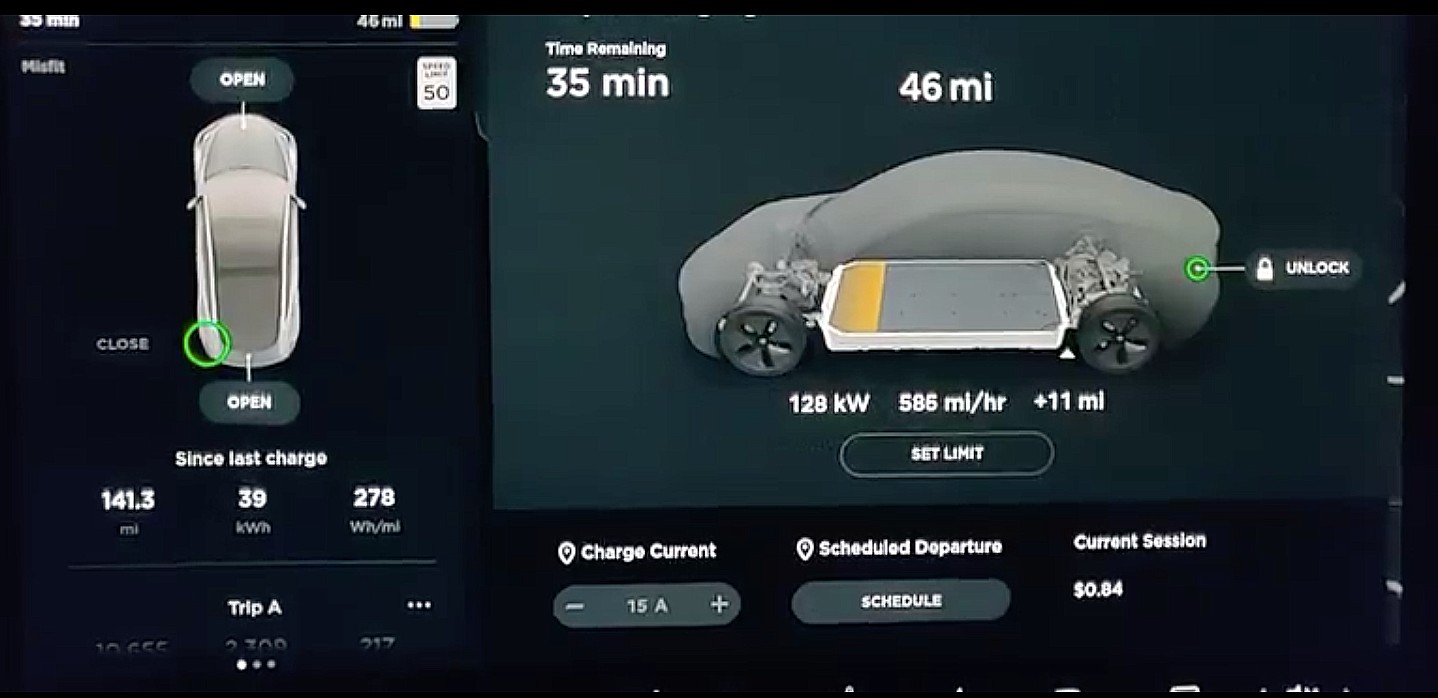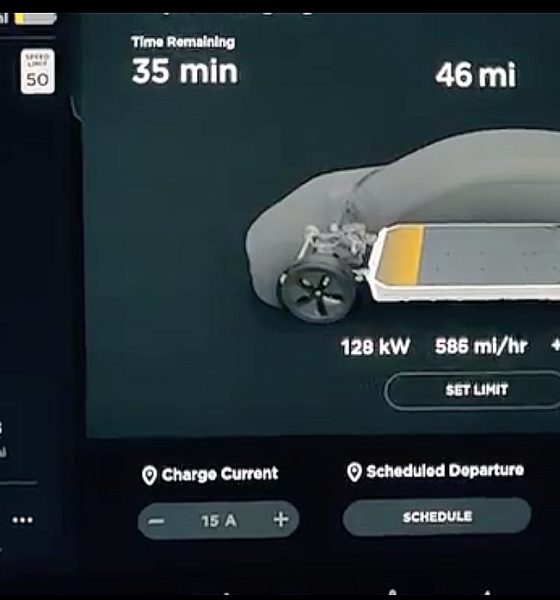

News
First look at Tesla Model 3 Standard Range Plus’ faster charging speed in action
A Tesla Model 3 Standard Range Plus owner recently demonstrated the improvements in his vehicle’s Supercharging speed following the release of the 2019.40.2.1 update. The over-the-air speed boost allows even lower-tier variants of the Model 3 to recharge their batteries at a rate that exceeds that of competitors.
In a post on Twitter, Tesla Model 3 owner @TeslaOwnersLV showed how his all-electric sedan was able to hit charging speeds of up to 601 mph. Prior to receiving the 2019.40.2.1 update, the Tesla enthusiast stated that his Model 3’s charging rate usually leveled off at around 100-106 kW.
Particularly interesting in the Model 3 owner’s video was the fact that the vehicle was not connected to Tesla’s fastest charger. It was taken at a V2 station, which has a maximum output of 150 kW. With a 250 kW V3 Supercharger, the Model 3 Standard Range Plus could charge at an even faster rate.
@Tesla @elonmusk
Taking advantage of the increase in charging rate (SR+) since update 2019.40.2.1
Thanks @elonmusk pic.twitter.com/eCKSqiBuan— Oh My Portugal! (@OhMyPortugal) December 16, 2019
Tesla has been rolling out improvements to the Supercharging speed of its more affordable vehicles as of late. In early November, Tesla released its version 2019.36.1 update, and one of its key upgrades was an increase in Supercharging peak power by 50-70%. Prior to the update, the Standard Range Plus Model 3 had a maximum 100 kW to 120 kW charge rate, which was ample but not on par with the charging speed of Tesla’s higher-tier vehicles.
The release notes for the Standard Range Plus’ charging speed boost were short and direct. “Your Model 3 is now able to charge with increased peak rate power up to 170 kW,” Tesla wrote. Yet, despite this simple description, the upgrade provided a great improvement to the user experience of the vehicle. Charging stops became shorter and faster, a big advantage for extended trips.
Confirmed! 2019.36.1 increases the peak supercharging power for Model 3 SR+ to 170kW. Source https://t.co/MTX9QHYj6P pic.twitter.com/fadz41eBlE
— Tesletter (@tesletter) November 3, 2019
But it’s not just the Standard Range Plus Model 3 that received a boost in Supercharging speeds. In late November, Tesla also introduced an increase in Supercharging peak power for the rare Mid-Range Model 3, raising its maximum charging speed to 200 kW with the Supercharger V3 Network. This was on top of the vehicle’s 5% performance boost, which reduced the Mid-Range Model 3’s 0-60 mph time to 4.9 seconds.
Tesla’s lead in battery tech and charging systems can be seen in how the company improves its vehicles’ specs over time. With its 170 kW peak charging rate, a sub-$40,000 Model 3 Standard Range Plus can replenish around 118 miles of its range in 10 minutes, provided that it is connected to one of Tesla’s 250 kW Supercharger V3 stations. In contrast, the $150,000 Porsche Taycan Turbo, with its 250 kW peak charging rate (at least for now), is able to recharge around 85 miles of its range in 10 minutes.
Along with faster Supercharging rates, the 2019.40.2.1 release notes talk about improvements in the Adjacent Lane Speeds feature, Automatic Wiper Fixes, and Autosteer Stop Sign Warnings.

News
Tesla is not sparing any expense in ensuring the Cybercab is safe
Images shared by the longtime watcher showed 16 Cybercab prototypes parked near Giga Texas’ dedicated crash test facility.

The Tesla Cybercab could very well be the safest taxi on the road when it is released and deployed for public use. This was, at least, hinted at by the intensive safety tests that Tesla seems to be putting the autonomous two-seater through at its Giga Texas crash test facility.
Intensive crash tests
As per recent images from longtime Giga Texas watcher and drone operator Joe Tegtmeyer, Tesla seems to be very busy crash testing Cybercab units. Images shared by the longtime watcher showed 16 Cybercab prototypes parked near Giga Texas’ dedicated crash test facility just before the holidays.
Tegtmeyer’s aerial photos showed the prototypes clustered outside the factory’s testing building. Some uncovered Cybercabs showed notable damage and one even had its airbags engaged. With Cybercab production expected to start in about 130 days, it appears that Tesla is very busy ensuring that its autonomous two-seater ends up becoming the safest taxi on public roads.
Prioritizing safety
With no human driver controls, the Cybercab demands exceptional active and passive safety systems to protect occupants in any scenario. Considering Tesla’s reputation, it is then understandable that the company seems to be sparing no expense in ensuring that the Cybercab is as safe as possible.
Tesla’s focus on safety was recently highlighted when the Cybertruck achieved a Top Safety Pick+ rating from the Insurance Institute for Highway Safety (IIHS). This was a notable victory for the Cybertruck as critics have long claimed that the vehicle will be one of, if not the, most unsafe truck on the road due to its appearance. The vehicle’s Top Safety Pick+ rating, if any, simply proved that Tesla never neglects to make its cars as safe as possible, and that definitely includes the Cybercab.
Elon Musk
Tesla’s Elon Musk gives timeframe for FSD’s release in UAE
Provided that Musk’s timeframe proves accurate, FSD would be able to start saturating the Middle East, starting with the UAE, next year.

Tesla CEO Elon Musk stated on Monday that Full Self-Driving (Supervised) could launch in the United Arab Emirates (UAE) as soon as January 2026.
Provided that Musk’s timeframe proves accurate, FSD would be able to start saturating the Middle East, starting with the UAE, next year.
Musk’s estimate
In a post on X, UAE-based political analyst Ahmed Sharif Al Amiri asked Musk when FSD would arrive in the country, quoting an earlier post where the CEO encouraged users to try out FSD for themselves. Musk responded directly to the analyst’s inquiry.
“Hopefully, next month,” Musk wrote. The exchange attracted a lot of attention, with numerous X users sharing their excitement at the idea of FSD being brought to a new country. FSD (Supervised), after all, would likely allow hands-off highway driving, urban navigation, and parking under driver oversight in traffic-heavy cities such as Dubai and Abu Dhabi.
Musk’s comments about FSD’s arrival in the UAE were posted following his visit to the Middle Eastern country. Over the weekend, images were shared online of Musk meeting with UAE Defense Minister, Deputy Prime Minister, and Dubai Crown Prince HH Sheikh Hamdan bin Mohammed. Musk also posted a supportive message about the country, posting “UAE rocks!” on X.
FSD recognition
FSD has been getting quite a lot of support from foreign media outlets. FSD (Supervised) earned high marks from Germany’s largest car magazine, Auto Bild, during a test in Berlin’s challenging urban environment. The demonstration highlighted the system’s ability to handle dense traffic, construction sites, pedestrian crossings, and narrow streets with smooth, confident decision-making.
Journalist Robin Hornig was particularly struck by FSD’s superior perception and tireless attention, stating: “Tesla FSD Supervised sees more than I do. It doesn’t get distracted and never gets tired. I like to think I’m a good driver, but I can’t match this system’s all-around vision. It’s at its best when both work together: my experience and the Tesla’s constant attention.” Only one intervention was needed when the system misread a route, showcasing its maturity while relying on vision-only sensors and over-the-air learning.
News
Tesla quietly flexes FSD’s reliability amid Waymo blackout in San Francisco
“Tesla Robotaxis were unaffected by the SF power outage,” Musk wrote in his post.

Tesla highlighted its Full Self-Driving (Supervised) system’s robustness this week by sharing dashcam footage of a vehicle in FSD navigating pitch-black San Francisco streets during the city’s widespread power outage.
While Waymo’s robotaxis stalled and caused traffic jams, Tesla’s vision-only approach kept operating seamlessly without remote intervention. Elon Musk amplified the clip, highlighting the contrast between the two systems.
Tesla FSD handles total darkness
The @Tesla_AI account posted a video from a Model Y operating on FSD during San Francisco’s blackout. As could be seen in the video, streetlights, traffic signals, and surrounding illumination were completely out, but the vehicle drove confidently and cautiously, just like a proficient human driver.
Musk reposted the clip, adding context to reports of Waymo vehicles struggling in the same conditions. “Tesla Robotaxis were unaffected by the SF power outage,” Musk wrote in his post.
Musk and the Tesla AI team’s posts highlight the idea that FSD operates a lot like any experienced human driver. Since the system does not rely on a variety of sensors and a complicated symphony of factors, vehicles could technically navigate challenging circumstances as they emerge. This definitely seemed to be the case in San Francisco.
Waymo’s blackout struggles
Waymo faced scrutiny after multiple self-driving Jaguar I-PACE taxis stopped functioning during the blackout, blocking lanes, causing traffic jams, and requiring manual retrieval. Videos shared during the power outage showed fleets of Waymo vehicles just stopping in the middle of the road, seemingly confused about what to do when the lights go out.
In a comment, Waymo stated that its vehicles treat nonfunctional signals as four-way stops, but “the sheer scale of the outage led to instances where vehicles remained stationary longer than usual to confirm the state of the affected intersections. This contributed to traffic friction during the height of the congestion.”
A company spokesperson also shared some thoughts about the incidents. “Yesterday’s power outage was a widespread event that caused gridlock across San Francisco, with non-functioning traffic signals and transit disruptions. While the failure of the utility infrastructure was significant, we are committed to ensuring our technology adjusts to traffic flow during such events,” the Waymo spokesperson stated, adding that it is “focused on rapidly integrating the lessons learned from this event, and are committed to earning and maintaining the trust of the communities we serve every day.”








